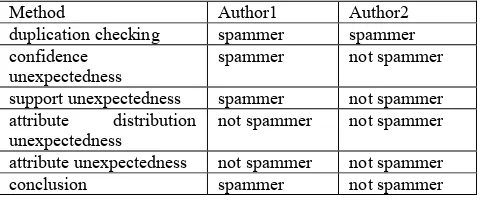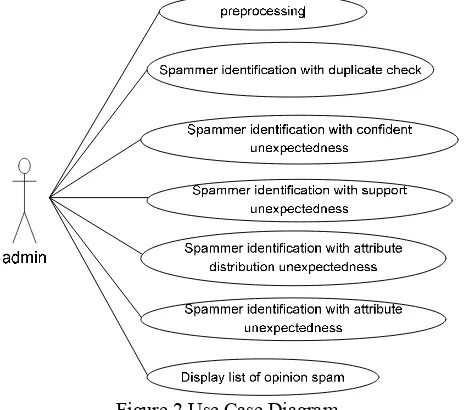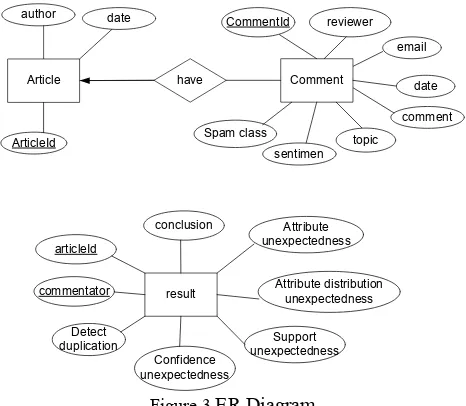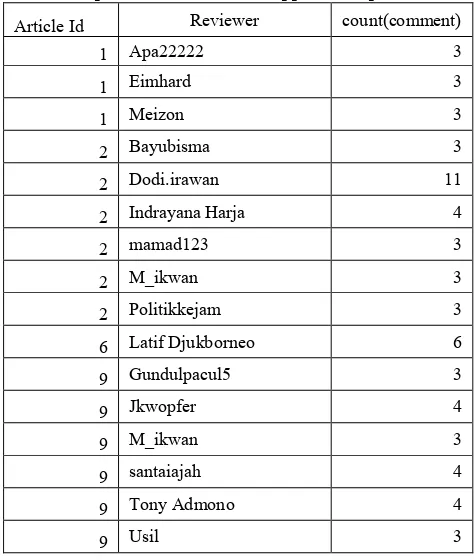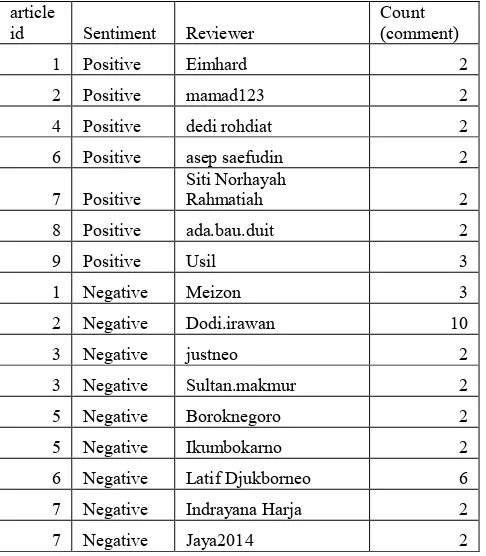How to detect spam in opinion mining
(case study use opinion written in Indonesian language)
Hilda Widyastuti
Batam State Polytechnic, [email protected]
Abstract
The existence of public opinion influenced purchasing decisions or political view, encourage the emergence of misleading spam opinion. Opinion mining needs to detect spam opinion, because spam opinion will be ignored from opinion mining. Indonesian society prefers to use Indonesian language when writing an article or an opinion. Based on this phenomenon, this research uses opinion written in Indonesian language.
This research uses five methods, duplicate checking method and some methods to detect abnormal behavior, namely support unexpectedness, confident unexpectedness, attribute distribution unexpectedness, and atribute unexpectedness method. This research also uses bagging method to combine the result from five methods above, to increase accuracy detection. This research can detect 7% of reviewers in this experiment as spammers.
Keywords: spammer, duplicate checking method, abnormal behavior detection, bagging
1. Introduction
The existence of social media makes a lot of people or organizations use public opinion as guidance to make decisions. For example, buying decision a particular brand of mobile phone device is based on the people’s opinions toward the brand. People’s opinion can be founded from Facebook fan page, Twitter, comments section which provided by online shopping and online news, etc.
Opinion mining has been developed to facilitate people use public opinion. Opinion mining is computation on public opinion, appreciation, attitude on an object, issues, events, a topic of discussion, and their attributes. Opinion mining aims to determine an opinion category, positive, negative, or neutral. Opinion mining implementation on public opinions of articles, generate a summary how many percentage of positive opinions, negative opinions, or neutral opinions from the readers. This summary allows prospective buyers to know other people's opinions on a particular of products and allows producer to know public response to their products. In online political news, this summary is useful for the reader to get better understanding of the political situation that changes very fast, and allow news sources and news managers to know public response toward their news.
The existence of public opinion influenced purchasing decisions or political view, encourage the emergence of misleading spam opinion, because spammers give the reader a false opinion. In opinion mining we need to detect spam opinion. Spam opinion will be ignored from opinion mining. According to [Jindal, Liu, 2008] there are three spam opinion types :
Type 1 (untruthful opinions): Those that deliberately mislead readers or opinion mining systems by giving undeserving positive reviews to some target objects in order to promote the objects and or by giving unjust or malicious negative reviews to some other objects in order to damage their reputation
Type 2 (reviews on brands only): Those that do not comment on the products in reviews specifically for the products but only the brands, the manufacturers or the sellers of the products. Although they may be useful, we consider them as spam because they are not targeted at the specific products and are often biased.
Type 3 (non-reviews): Those that are non reviews, which have two main sub-types: (1) advertisements and (2) other irrelevant reviews containing no opinions (e.g., questions, answers, and random texts). Second and third types opinion are more clearly, so it is predictable and is determined solely by admin. For handling second and third types in a case which has many opinions, first determine spam opinion manually by admin from training data. Then classify training data to produce spam model. This spam model will be applied to classify other opinions.
Determining first spam opinion is difficult to do manually. Previous research handles this type by duplication check using Jaccard method. If some opinions have very high degree similarity, there is a possibility those opinions is spam opinion. To ensure the answer, we must check reviewer name, opinion purpose product, date and time creation.
2
2. Previous Works 2.1 Spam opinion
Writing spam opinion is illegal activity which try to mislead readers or automatic opinion mining or sentiment analysis system. The spam opinion writers write false opinion or shilling, for example give positive opinion for some entities target to promote target entity or give negative opinion for some other entities to destroy entity reputation. Other name of spam opinion are fake opinion, bogus opinion, or fake review.
There are two categories of spam opinion writers, namely individual spammer and collective spammer. Individual spammer have registered as single author or have some user ids. Collective spammer join together to promote certain entity and or destroy reputation certain entity. This group can be very dangerous, because they can control product sentiment and plunges potential customers.
2.2 Data type in spam detection
According [Liu, 2012] there are three data types used in spam detection :
a. Content review, actual text content on any review b. Meta data review, for example rating from reviewer,
reviewer user id, time of making the review, reviewer IP address, reviewer location, click sequence in review site. With support those data, we can mine reviewer habit and review that is not normal.
c. Product information, information of entity which has been reviewed. For example product description and sales volume.
2.3 Methods to detect spam
Method to detect spam according[Liu, Zhang, 2012] : a. Spam detection with supervision learning
Spam detection considered as classification problem with two classes, spam and not spam. Model building process needs training data contained class. One way to prepare training data is by labelling training data manually. It is possible for second type and third type of spam opinion. [Liu, 2012] use Logistic Regression model when building classification model. There are three feature which can be used in classification :
Review centric features: these are features about the content of reviews. Example features include actual words in a review, the number of times that brand names are mentioned, the percentage of opinion words, the review length, and the number of helpful feedbacks.
Reviewer centric features: these are features about each reviewer. Example features include the average rating given by the reviewer, the standard deviation in rating, the ratio of the number of reviews that the reviewer wrote which were the first reviews of the products to the total
number of reviews that he/she wrote, and the ratio of the number of cases in which he/she was the only reviewer.
Product centric features: these are features about each product. Example features include the price of the product, the sales rank of the product
b. Spam detection with duplicate detection
Labelling data manually for first type of spam opinion is very difficult, because spammers write spam opinion like other writer. Actually we frequently find duplicate opinion or near duplicate. There are three types of duplicate opinions :
Opinion duplication from different ID’s writers in same product
Opinion duplication from same ID’s writer in different product
Opinion duplication from different ID’s writer in different product
According [Jindal, Liu, 2008] duplicate opinions from same ID’s writer in same product is not classified into spam. For example, writer accidentally click mouse twice. Duplicate detection is processed by shingle method. Similarity calculation is used Jaccard distance. Pairs of data which have degree similarity minimal 90% is regarded as duplicate pair. c. Spam detection based on abnormal behaviors
Manual labelling is very difficult, so duplicate opinion is considered as spam which describe in section b. Actually there are many spam opinions that are not duplicate. This case is overcome by identification abnormal behavior of opinion maker with finding unexpected rule. The unexpected rule types include :
Confidence unexpectedness: using this measure, we can find reviewers who give all high ratings to products of a brand, but most other reviewers are generally negative about the brand.
Support unexpectedness: using this measure, we can find reviewers who write multiple reviews for a single product, while other reviewers only write one review.
Attribute distribution unexpectedness: using this measure, we can find that most positive reviews for a brand of products are from only one reviewer although there are a large number of reviewers who have reviewed the products of the brand.
3
reviews to one brand, and only negative reviews to another brand.
d. Group spammer detection. There are two steps :
Frequent pattern mining : first, it extracts the review data to produce a set of transactions. Each transaction represents a unique product and consists of all the reviewers (their ids) who have reviewed that product. Using all the transactions, it performs frequent pattern mining. The patterns thus give us a set of candidate groups who might have spammed together
Rank groups based on a set of group spam indicators: The groups discovered in step 1 may not all be spammer groups. Many of the reviewers are grouped together in pattern mining simply due to chance. Then, this step first uses a set of indicators to catch different types of unusual group behaviors. These indicators including writing reviews together in a short time window, writing reviews right after the product launch, group content similarity, group rating deviation, etc. It then ranks the discovered groups from step 1 based on their indicator values using SVM rank.
2.4 Increasing detection accuracy with bagging There are five methods for detecting spam used in this paper, i.e. (1) duplication checking, (2) confident unexpectedness, (3) support unexpectedness, (4) attribute distribution unexpectedness, and (5) attribute unexpectedness. Author combines five methods to improve the result accuracy with bagging method.
The illustration at how bagging work as a method of increasing accuracy. Suppose that you are a patient and would like to have a diagnosis made based on your symtoms. Instead of asking one doctor, you may choose to ask several. If a certain diagnosis occurs more than any of the others, you may choose this as the final diagnosis. The final diagnosis is made based on a majority vote, where each doctor gets an equal vote[Han, Kamber, 2006]. Now replace each doctor by a method. Let each of the five methods classify an author is a spammer and return the majority vote. For example data in table 1. Author 1 is spammer, because the majority vote from five methods is spammer. While author 2 is not spammer.
Table 1 Bagging Illustration
Method Author1 Author2
duplication checking spammer spammer confidence
unexpectedness spammer not spammer support unexpectedness spammer not spammer attribute distribution
unexpectedness not spammer not spammer attribute unexpectedness not spammer not spammer conclusion spammer not spammer
2.5 Measuring document similarity with cosine similarity
According [Widyastuti, 2008] document is represented as non sequence and sequence. At non sequence representation, document is considered as words collection (bag of word) which only focus on words frequency while the order is not considered. At sequence representation, document is considered as sequence of word collections or n-grams. At document text preprocessing, non sequence and sequence representation is used as vector representation with words or n-gram as vector components.
The similarity of two documents is measured by cosine value of two vector or cosine similarity [Huang, 2008]. The formula of cosine similarity = A . B
||A|| ||B||
A and B indicate two vectors which contains the number of occurences of words having m dimensions, where A={a1, a2, a3, a4.., am} and B= {b1, b2, b3, b4.., bm}
3. Research Objectives and Benefits Research objectives are :
a. Detecting spammer which write review in Indonesian language using five methods, namely duplication checking, confident unexpectedness, support unexpectedness, attribute distribution unexpectedness, and attribute unexpectedness b. Increasing accuracy of spammer detection with
bagging method.
Research benefits are detecting spam opinion from opinion collection in Indonesian language. If it is detected as spam, the opinion will be excluded from opinion mining.
4. Stages of Research
The stages of research include collecting opinion data, software analysis and software design, and software implementation, and software testing.
4.1 Collecting opinion data
This experiment uses nine political news from www.detik.com collected on October 8, 2014 up to October 16, 2014. Each news has some comments from readers. Details of the number of comments on each news are in table 1.
Table 2 Details of experiment data
4
No News Number of comments 8 [Ledysia, 2014] 42
9 [Sitorus, 2014] 175
Total 980
4.2 Software analysis and software design 4.2.1 General Description
Figure 1 General description of system
Admin copy comments from www.detik.com to a text file, then Checker Spam software will read these text files. Checker Spam Software will perform multiple processes, i.e. parsing the contents of a text file, save it to database, detect opinion spam, and display opinion spam to the computer screen. To support functionality of software, admin also update topic and sentiment of each comment manually. Actually in next development, this step can be processed automatically uses topic summary and sentiment analysis feature.
4.2.2 Functionality requirement and non functionality requirement
Functionality requirement consists of seven requirements, F1 up to F7 in this table :
Id Description F1 Preprocessing data
F2 Identify spammer with duplicate check
F3 Identify spammer with confident unexpectedness F4 Identify spammer with support unexpectedness F5 Identify spammer with attribute distribution
unexpectedness
F6 Identify spammer with attribute unexpectedness F7 Display list of opinion spam
Non functionality requirement is software can handle data in Indonesian language.
4.2.3 Supporting Software
There are some supporting software which were used for application implementation:
a. Operating system : Windows 7 b. Database management
system : MySQL 5.5.25a
c. Tool for development : Netbeans IDE 7.0
4.2.4 Use case diagram
The actor involved is admin. Admin can access on seven processes, namely preprocessing, spammer identification with duplicate checks, spammer identification with confident unexpectedness, spammer identification with support unexpectedness, spammer
identification with attribute distribution unexpectedness, spammer identification with attribute unexpectedness, and displays a list of opinion spam. Use case diagram is in figure 2, while scenario of seven processes are in table 3 up to table 9.
Figure 2 Use Case Diagram Table 3 Scenario of preprocessing Use case preprocessing
Description transform unstructured data in text file to structured form
Initial
condition There are some article and comments in www.detik.com Final condition The data is saved to t_comment and t_article
table
Scenario 1. Admin inputs data to t_article 2. Admin copies some comments from
www.detik.com to text file 3. Read data from text file
4. Parse data include reviewer, email, time, and comment, based specific criteria and save it to t_comment table
5. Admin updates column topic and sentiment of comment manually 6. Find idArticle and reviewers in all
articles, save it into t_result
Table 4 Spammer identification with duplicate checks Use case Spammer identification with duplicate checks
Description Detect spammer
Initial condition There are some data in t_comment
Final condition Spammer is saved to t_result
5
comments on t_comment
2. If similarity is equal or more than 80% then :
2.1 compare reviewer of two articles. 2.1.1 If reviewers are different, reviewer is
spammer
2.1.2 If reviewers are same, check date and time of two articles
2.1.2.1 If date and time are different, reviewer is spammer
3. Update column detect duplication in t_result with value 1
Table 5 Spammer identification by confident unexpectedness
Use case Spammer identification by confident unexpectedness
Description find reviewers who give all high ratings to article, but most other reviewers are generally negative and vice versa.
Initial condition There are some data in t_comment Final condition Spammer is saved to t_result
Scenario 1. Detect number of positive sentiment, negative sentiment, and neutral sentiment in articles.
2. Identify the majority sentiment in each articles.
3. The reviewers which sentiment are different with majority sentiment are spammer
4. Update column confident unexpectedness in t_result with value 1
Table 6 Spammer identification by support unexpectedness Use case Spammer identification by support
unexpectedness
Description count number of comments written by readers in an article
Initial condition There are some data in t_comment Final condition Spammer is saved to t_result
Scenario 1. Count number of comments written by reviewers in an article
2. If the number of comments is more than 2, the reviewer is spammer
3. Update column support unexpectedness in t_result with value 1
Table 7 Spammer identification by attribute distribution unexpectedness
Use case Spammer identification by attribute distribution unexpectedness
Description find that most positive reviews for a brand of products are from only one reviewer although there are a large number of reviewers who have reviewed the products of the brand
Initial condition There are some data in t_comment
Final condition Spammer is saved to t_result
Scenario 1. Find reviewer which written most review positive in an articles
2. Find reviewer which written most review negative in an articles
3. The reviewers are spammer 4. Update column attribute distribution
unexpectedness in t_result with value 1
Table 8 Spammer identification by attribute unexpectedness Use case Spammer identification by attribute
unexpectedness
Description find reviewers who write only positive reviews to one brand, and only negative reviews to another brand
Initial condition There are some data in t_comment
Final condition Spammer is saved to t_result
Scenario 1. Find the reviewer which give consistent sentiment in a topic of all articles. The reviewer is spammer
2. Update column attribute unexpectedness in t_result with value 1
Table 9 displays a list of opinion spam Use case Displays a list of opinion spam
Description Display all comments which have spam type
Initial condition There are some data in t_comment
Final condition Display a list of opinion spam into computer screen
Scenario 1. Add all the value of all column in t_result for each reviewer
2. If the value is equal or more than 3, reviewer is spammer
6
“spam” in t_comment, where the reviewer is spammer
4.2.5 Entity Relationship Diagram (ER Diagram) There are three entities in ER diagram in figure 3, namely article, comment, and result. An article has many comments. A comment is owned by an article. Result entity saves some result from five method which used in this research.
Figure 3 ER Diagram 4.2.6 Design Table
The tables designed based ER diagram are in table 10, table 11, and table 12.
Table 10 t_article
Field Data type Explanation ArticleId Integer Primary key Author Varchar(50) Article writer Date Varchar(30) Article date
Table 11 t_comment
Field Data type Explanation CommentId integer Primary key ArticleId Integer Foreign key from
t_article Reviewer Varchar(30) Comment writer Email Varchar(100) Commentator’s
email Date Varchar(30) Date and time Comment Varchar(2000) Content
Topic Varchar(30) Comment keyword Sentiment Varchar(10) [positive, negative,
neutral]
Spam_class Varchar(10) [spam, not spam]
Table 12 t_result
Field Data type Explanation ArticleId integer Primary key Commentator Varchar(30) Primary key Detect
duplication Integer Result duplication method [1,0] from detect Confident
unexpectedness Integer Result unexpectedness from confident method [1,0]
Support
unexpectedness Integer Result unexpectedness from support method [1,0]
Attribute distribution unexpectedness
Integer Result from attribute distribution unexpectedness method [1,0]
Attribute
unexpectedness Integer Result unexpectedness from attribute method [1,0]
Conclusion integer sum of result from five methods
4.3 Software implementation and software testing Spam Checker Software implementation is based on software analysis and design. The software is built use Java language with Netbeans IDE 7.0. Author also use cosine similarity code from [Kumar, 2014]. The data is saved into database management system (DBMS) MySQL 5.5.25a. The database name is komentarpolitik, contains three tables namely t_article, t_comment, and t_result. The software is tested use black box method.
5. Result and Discussion
Data preprocessing produce 980 comments from nine articles. The number of comments of each articles are displayed in table 1. Preprocessing data do not use stop word removal and do not stem process, because the author want to process comments in original form. So this research also can process comments in another language, for example english. The experiment result is written in table 13. Value 1 indicates reviewer is spammer.
Author get spammers from five methods, namely duplicate check method, support unexpectedness method, confident unexpectedness method, attribute distribution unexpectedness method, and attribute unexpectedness method. After that, author adds all the value of all column in t_result for each reviewer. If the value is equal or more than 3, reviewer is spammer. Author chooses 3, because value 3 represent minimal value of majority vote. Author also update column spam class with value “spam” in t_comment, where the reviewer is spammer. Author can detect 7% of reviewers in this experiment are spammers.
Table 13 Experiment result Article
Id Reviewer M1 M2 M3 M4 M5 Total
7
Article
Id Reviewer M1 M2 M3 M4 M5 Total
2 mamad123 1 1 1 1 1 5
1 Eimhard 1 1 1 1 4
2 Indrayana Harja 1 1 1 1 4
6 Latif Djukborneo 1 1 1 1 4
9 santaiajah 1 1 1 1 4
8 ada.bau.duit 1 1 1 3
2 Bayubisma 1 1 1 3
9 dantariksa 1 1 1 3
4 dedi rohdiat 1 1 1 3
2 Dodi.irawan 1 1 1 3
9 gomis 1 1 1 3
9 Gundulpacul5 1 1 1 3
5 Ikumbokarno 1 1 1 3
9 Indonesia_makmur 1 1 1 3
1 Meizon 1 1 1 3
7 Siti Norhayah Rahmatiah 1 1 1 3
9 Tony Admono 1 1 1 3
9 Usil 1 1 1 3
6 Asef Saefudin 1 1 2
3 Exmud_muda 1 1 2
2 Goldindonesia 1 1 2
…. …. …. …. …. …. ….
7 Zulll 1 1
Explanation :
M1 : result from duplicate check method M2 : result from support unexpectedness method M3 : result from confident unexpectedness method M4 : result from attribute distribution unexpectedness method
M5 : result from attribute unexpectedness method
5.1 Result from duplicate check method
Author found some reviewers that detected as spammer with duplicate check method, because their comment have similarity equal or more than 80% with other comment. Detail information can be read in table 14.
a. Agus Setiawan is spammer, because he send same comment with Rahmad Budiani’s comment. It is based theory which opinion duplication from different ID’s writers in same product is spam. b. Rahmad Budiani is spammer. The reason is same
with explanation in point a.
c. Heri Purwanto and Bejogembul are spammers. The reason is same with explanation in point a.
d. Ronaldo Rabbani, Indrayana Harja, Latif Djukborneo, M_ikwan, Mamad123, Ikumbokarno are spammers because they write two comments at long interval.
Table 14 Experiment result from duplicate check method
Article Id
Comment 1 Comment 2
Reviewer Time Reviewer Time 1 Ronaldo Rabbani 14:02:19 Ronaldo Rabbani 13:02:14 1 agus setiawan 13:28:58 Rahmad Budiani 12:13:34 2 Indrayana Harja 16:06:45 Indrayana Harja 15:31:02 2 Heri Purwanto 09:42:23 bejogembul 09:26:51 6 Latif Djukborneo 11:52:11 Latif Djukborneo 11:43:01 9 M_ikwan an hour ago M_ikwan 2 hours ago 2 Mamad123 07:56:03 Mamad123 07:49:34 5 Ikumbokarno 08:09:17 Ikumbokarno 07:54:27 5.2 Result from support unexpectedness method Author found reviewers which write many opinions in a product while other reviewers only write one review. The result can be read in table 15. Those reviewers are spammer.
Table 15 Experiment result from support unexpectedness Article Id Reviewer count(comment)
1 Apa22222 3
1 Eimhard 3
1 Meizon 3
2 Bayubisma 3
2 Dodi.irawan 11
2 Indrayana Harja 4
2 mamad123 3
2 M_ikwan 3
2 Politikkejam 3
6 Latif Djukborneo 6
9 Gundulpacul5 3
9 Jkwopfer 4
9 M_ikwan 3
9 santaiajah 4
9 Tony Admono 4
8
5.3 Result from confident unexpectedness method Firstly author check the majority sentiment of each article. Detail information about majority sentiment can be read in table 16. After that reviewers which sentiment are different with majority sentiment are spammer. For example in article 9, M_Ikwan write review with sentiment negative, while majority sentiment in article 9 is positive, so M_Ikwan is spammer.
Table 16 Majority sentiment information
Article Id Majority Sentiment Percentage
1 Negative 85%
2 Negative 60%
3 Negative 58%
4 Negative 55%
5 Negative 59%
6 Negative 74%
7 Negative 65%
8 Negative 40%
9 Positive 49%
5.4 Result from attribute distribution unexpectedness method
Author found reviewers which written most review positive in an articles, and also found reviewers which written most review negative in an articles. Those reviewers are spammer. Detail information can be read in table 17.
Table 17 Experiment result from attribute distribution unexpectedness method
article
id Sentiment Reviewer Count (comment)
1 Positive Eimhard 2
2 Positive mamad123 2
4 Positive dedi rohdiat 2
6 Positive asep saefudin 2
7 Positive Siti Norhayah Rahmatiah 2
8 Positive ada.bau.duit 2
9 Positive Usil 3
1 Negative Meizon 3
2 Negative Dodi.irawan 10
3 Negative justneo 2
3 Negative Sultan.makmur 2
5 Negative Boroknegoro 2
5 Negative Ikumbokarno 2
6 Negative Latif Djukborneo 6 7 Negative Indrayana Harja 2
7 Negative Jaya2014 2
article
id Sentiment Reviewer Count (comment)
8 Negative mqits 2
8 Negative Tybalt 2
9 Negative dantariksa 2
…. ….
5.5 Result from attribute unexpectedness method
Author found reviewer which give consistent sentiment in a topic of all articles. The reviewer is spammer. For example, “Ada.bau.duit” always write positive comments with topic “ical”. While “An.Arki” always write negative comments with topic Jokowi. More complete result from
attribute unexpectedness method can be read in table 18.
Table 18 Experiment result from attribute unexpectedness method
Reviewer Topic Sentiment
Ada.bau.duit ical Positive Dedi Rohdiat PPP Positive Eimhard kabinet kerja Positive
Exmud_muda PPP Positive
Gundulpacul5 Jokowi Positive
. . . . . . .
An.Arki Jokowi Negative
b4716rg hasyim Negative
Bayubisma KMP Negative
Capedeloe hasyim Negative dantariksa sampul majalah Negative
. . . . . . . . . . . .
6. Conclusion
The research conclusion are :
1. Detecting 7% of reviewers in this experiment are spammers using five methods, namely duplicate checking, confident unexpectedness, support unexpectedness, attribute distribution unexpectedness, and attribute unexpectedness. 2. Increasing accuracy of spammer detection with
bagging method.
3. The software can detect opinion spam in other language, not only in Indonesian language.
The idea to develop this research are :
9
2. Implement analysis sentiment and topic summary feature, so author do not give topic and sentiment to each review manually.
References
[Huang, 2008] Huang, 2008, Similarity Measures for Text Document Clustering, New
Zealand Computer Science Research Student Conference (14-18 April
2008), pp. 49-56. [Liu, Zhang,
2012] B. Liu, L. Zhang, 2012, A Survey of Opinion Mining and Sentiment Analysis [Liu, 2012] B. Liu, 2012, Sentiment Analysis and
Opinion Mining, Morgan & Claypool. [Jindal, Liu,
2007] N. Jindal, B. Liu, 2007, Review Spam Detection, Proceedings dari International Conference on World Wide Web
[Jindal, Liu,
2008] N. Jindal, B. Liu, 2008, Opinion spam and Analysis, Proceeding dari Conference on Web Search and Web Data Mining.
[Han, Kamber, 2006]
J. Han, M. Kamber, 2006, Data Mining: Concepts and Techniques, 2nd edition, Morgan Kaufmann: San Fransisco.
[Widyastuti,
2008] H. Widyastuti, 2008, Studi Representasi N-Gram pada Algoritma HMRF-KMeans untuk Document Clustering, Tesis, Institut Teknologi Bandung
[Toriq, 2014] A. Toriq, 2014, Hashim Klarifikasi Soal Pernyataan 'Hambat Jokowi, www.detik.com, diakses pada tanggal 10/10/2014.
[Muhaimin,
2014] R. Muhaimin, 2014, KMP akan Sapu Bersih Parlemen, PDIP: Ini Melebihi Rezim Suharto, www.detik.com, diakses pada tanggal 09/10/2014.
[Ray, 2014] J. Ray, 2014, PPP Merapat ke KIH, Jokowi: Insya Allah Permanen, www.detik.com, diakses pada tanggal 08/10/2014.
[Khabibi,
2014] I. Khabibi, 2014, Menyeberang ke KIH Agar Dapat Jatah Kursi, PPP Malah Kembali Gigit Jari, www.detik.com, diakses pada tanggal 08/10/2014.
[Muhaimin,
2014] R. Muhaimin, 2014, Hashim Ingin Hambat Jokowi, PDIP: KMP Masih Tak Siap Kalah, www.detik.com, diakses pada tanggal 09/10/2014.
[Ledysia,
2014] S. Ledysia, 2014, Golkar Bantah Pernyataan Hashim KMP akan Hambat Pemerintahan Jokowi-JK, www.detik.com, diakses pada tanggal 08/10/2014.
[Ledysia,
2014] S. Ledysia, 2014, KMP Menang Bikin Saham Jadi Anjlok, Ini Tanggapan Golkar, www.detik.com, diakses pada tanggal 08/10/2014.
[Ledysia,
2014] S. Ledysia, 2014, Ical: KMP Akan Perbaiki 122 UU, Salah Satunya UU Perbankan, www.detik.com, diakses pada tanggal 08/10/2014.
[Sitorus,
2014] R. Sitorus, 2014, Jokowi Jadi Sampul Majalah TIME 'A New Hope', www.detik.com, diakses pada tanggal
16/10/2014. [Kumar,
